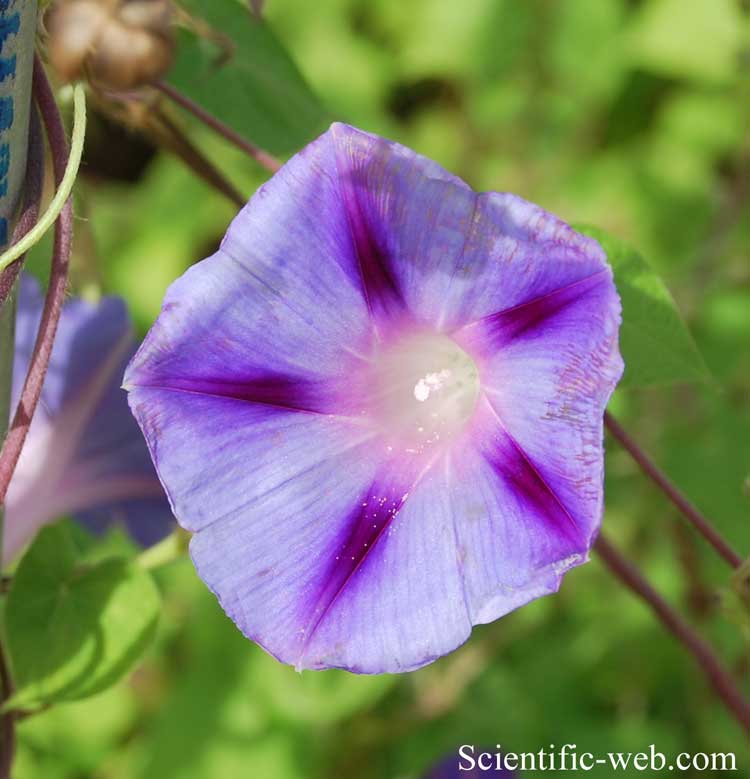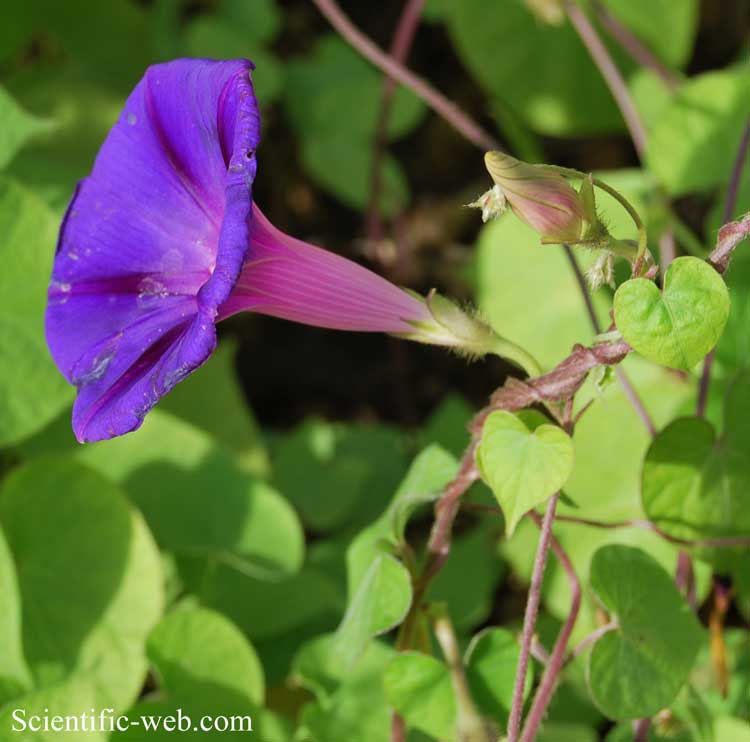
Ipomoea purpurea, Photo: Michael Lahanas
Classification System: APG IV
Superregnum: Eukaryota
Regnum: Plantae
Cladus: Angiosperms
Cladus: Eudicots
Cladus: Core eudicots
Cladus: Asterids
Cladus: Lamiids
Ordo: Solanales
Familia: Convolvulaceae
Tribus: Ipomoeeae
Genus: Ipomoea
Subgenus: I. subg. Ipomoea
Sectio: I. sect. Pharbitis
Series: I. ser. Pharbitis
Species: Ipomoea purpurea
Name
Ipomoea purpurea (L.) Roth, Bot. Abh. Beobacht.: 27 (1787).
Synonyms
Basionym
Convolvulus purpureus L., Sp. Pl. ed. 2: 219 (1762).
Homotypic
Convolvuloides purpurea (L.) Moench, Methodus: 452 (1794).
Convolvulus mutabilis Salisb., Prodr. Stirp. Chap. Allerton: 123 (1796), nom. superfl.
Pharbitis purpurea (L.) Bojer, Hortus Maurit.: 227 (1837).
Diatrema purpurea (L.) Raf., Fl. Tellur. 4: 72 (1838).
Heterotypic
Convolvuloides leucosperma Moench, Methodus: 452 (1794).
Ipomoea discolor Jacq., Pl. Hort. Schoenbr. 3: 6 (1798).
Ipomoea glandulifera Ruiz & Pav., Fl. Peruv. 2: 12 (1799).
Convolvulus pilosus Rottler, Ges. Naturf. Freunde Berlin Neue Schriften 4: 196 (1803).
Ipomoea hispida Zuccagni, Cent. Observ. Pl. 1: 15 (1806).
Ipomoea intermedia Schult., Observ. Bot.: 37 (1809).
Ipomoea hirsutula J.Jacq., Ecl. Pl. Rar. 1: 65 (1813).
Convolvulus eriocaulos Roem. & Schult., Syst. Veg., ed. 15 bis 4: 301 (1819).
Convolvulus intermedius Roem. & Schult., Syst. Veg., ed. 15 bis 4: 264 (1819), nom. illeg.
Convolvulus schultesii Roem. & Schult., Syst. Veg., ed. 15 bis 4: 790 (1819).
Ipomoea zuccagnii Roem. & Schult., Syst. Veg., ed. 15 bis 4: 230 (1819).
Ipomoea purpurea var. superba Ledeb., Index Seminum (TU, Dorpatensis) 1822: 11 (1822).
Convolvulus glandulifer Spreng., Syst. Veg. 1: 599 (1824).
Pharbitis hispida (Zuccagni) Choisy, Mém. Soc. Phys. Genève 6: 438 (1833 publ. 1834)[Conv. Or.: 56]
Convolvulus hirsutulus (J.Jacq.) Colla, Herb. Pedem. 4: 205 (1835).
Pharbitis diversifolia Lindl., Edwards's Bot. Reg. 23: t. 1988 (1837).
Ipomoea affinis M.Martens & Galeotti, Bull. Acad. Roy. Sci. Bruxelles 12(9): 263 (1845).
Ipomoea nil var. diversifolia (Lindl.) Choisy in A.P.de Candolle, Prodr. 9: 343 (1845).
Ipomoea pilosissima M.Martens & Galeotti, Bull. Acad. Roy. Sci. Bruxelles 12(9): 264 (1845).
Pharbitis githaginea Hochst. ex Choisy in A.P.de Candolle, Prodr. 9: 341 (1845).
Pharbitis nil var. diversifolia (Lindl.) Choisy in A.P.de Candolle, Prodr. 9: 343 (1845).
Pharbitis hispida var. imberbis Beurl., Kongl. Vetensk. Acad. Handl. 40: 138 (1854 publ. 1856).
Ipomoea purpurea f. triloba Meisn. in C.F.P.von Martius & auct. suc. (eds.), Fl. Bras. 7: 223 (1869).
Ipomoea mexicana A.Gray, Syn. Fl. N. Amer. 2(1): 210 (1878), nom. illeg.
Ipomoea wattii C.B.Clarke, J. Linn. Soc., Bot. 25: 49 (1889).
Ipomoea purpurea f. kermesina Voss, Vilm. Blumengärtn. ed. 3, 1: 710 (1895).
Ipomoea chanetii H.Lév., Repert. Spec. Nov. Regni Veg. 9: 452 (1911).
Ipomoea purpurea var. diversifolia (Lindl.) O'Donell, Lilloa 26: 385 (1953).

Ipomoea purpurea, Photo: Michael Lahanas
Distribution
Native distribution areas:
Continental: Northern America
Mexico (Aguascalientes, Baja California Sur, Campeche, Chiapas, Chihuahua, Coahuila, Colima, Ciudad de Mexico, Durango, Guanajuato, Guerrero, Hidalgo, Jalisco, Mexico State, Michoacan, Morelos, Nayarit, Nuevo Leon, Oaxaca, Puebla, Queretaro, Quintana Roo, San Luis Potosi, Sinaloa, Sonora, Tabasco, Tamaulipas, Tlaxcala, Veracruz, Yucatan, Zacatecas)
Continental: Southern America
Guatemala, Honduras, El Salvador, Nicaragua, Panama, Costa Rica, Argentina (Buenos Aires, Catamarca, Chaco, Cordoba, Corrientes, Distrito Federal, Entre Rios, Jujuy, La Rioja, Mendoza, Misiones, Salta, Santa Fe, San Juan, Tucuman), S-Brazil (Rio Grande do Sul, Santa Catarina), Chile (Valparaiso, Reg. Metropolitana), Uruguay (Montevideo, Paysandu), Bolivia (Chuquisaca, Cochabamba, La Paz, Potos, Santa Cruz, Tarija), Colombia (Antioquia, Boyac, Caldas, Cauca, Cundinamarca, Huila, La Guajira, Magdalena, Putumayo, Santander, Tolima, Valle), Ecuador, Peru, N-Brazil (Amazonas, Acre), NE-Brazil (Bahia), WC-Brazil (Goias, Distrito Federal), SE-Brazil (Minas Gerais, Espirito Santo, Sao Paulo, Rio de Janeiro), Venezuela (Aragua, Distrito Federal, Lara, Merida, Miranda, Tachira, Trujillo)
References: Brummitt, R.K. 2001. TDWG – World Geographical Scheme for Recording Plant Distributions, 2nd Edition
References
Primary references
Roth, A.W. 1787. Botanische Abhandlungen und Beobachtungen. 68 pp + xii tab., Nürnberg: Iohann Iacob Winterschmidt. BHL Reference page. : 27.
Links
Govaerts, R. et al. 2019. Ipomoea purpurea in World Checklist of Selected Plant Families. The Board of Trustees of the Royal Botanic Gardens, Kew. Published on the internet. Accessed: 2019 November 15. Reference page.
Hassler, M. 2019. Ipomoea purpurea. World Plants: Synonymic Checklists of the Vascular Plants of the World In: Roskovh, Y., Abucay, L., Orrell, T., Nicolson, D., Bailly, N., Kirk, P., Bourgoin, T., DeWalt, R.E., Decock, W., De Wever, A., Nieukerken, E. van, Zarucchi, J. & Penev, L., eds. 2019. Species 2000 & ITIS Catalogue of Life. Published on the internet. Accessed: 2019 November 15. Reference page.
International Plant Names Index. 2019. Ipomoea purpurea. Published online. Accessed: November 15 2019.
Tropicos.org 2019. Ipomoea purpurea. Missouri Botanical Garden. Published on the internet. Accessed: 2019 November 15.
USDA, ARS, Germplasm Resources Information Network. Ipomoea purpurea in the Germplasm Resources Information Network (GRIN), U.S. Department of Agriculture Agricultural Research Service. Accessed: 07-Oct-06.
Ipomoea purpurea – Taxon details on National Center for Biotechnology Information (NCBI).
Vernacular names
Deutsch: Purpur-Prunkwinde
English: Common morning glory, tall morning glory
español: Campanilla morada
eesti: Verev lehtertapp
suomi: Aitoelämänlanka
français: Volubilis
magyar: Kerti hajnalka
հայերեն: Այգածաղիկ ծիրանեգույն
日本語: マルバアサガオ
svenska: Purpurvinda
Türkçe: Kahkaha çiçeği
Ipomoea purpurea, the common morning-glory,[2] tall morning-glory,[3] or purple morning glory, is a species in the genus Ipomoea, native to Mexico[4] and Central America.
Contents
1 Description
2 Distribution and habitat
3 Chemistry
3.1 Flower color
3.2 Toxic treatments
4 Gallery
5 See also
6 References
7 External links
Description
Like all morning glories, the plant entwines itself around structures, growing to a height of 2–3 m (6 ft 7 in–9 ft 10 in) tall. The leaves are heart-shaped and the stems are covered with brown hairs. The flowers are trumpet-shaped, predominantly blue to purple or white, and 3–6 cm (1.2–2.4 in) in diameter.[5]
Distribution and habitat
The plant is predisposed to moist and rich soil, but can be found growing in a wide array of soil types.[6] It is naturalized throughout warm temperate and subtropical regions of the world. Although it is often considered a noxious weed, I. purpurea is also grown for its attractive purple and white flowers, and has many cultivars. Common cultivars include I. purpurea 'Crimson Rambler' (red-violet blossoms with white throats), 'Grandpa Ott's', 'Kniola's Black Knight', 'Star of Yelta' (blossoms in varying shades of deep purple with white or pale pink throats), and 'Milky Way' (white corolla with mauve accents).
Chemistry
The triangular seeds have some history of use as a psychedelic; they, like I. tricolor, may contain LSA.[6] Effects are reported to be somewhat similar to those of LSD.[7]
Flower color
Acylated cyanidin glycosides can be isolated from violet-blue flowers of I. purpurea. These anthocyanins were all based on cyanidin 3-sophoroside-5-glucoside, acylated with caffeic acid and/or p-coumaric acid.[8]
Acylated pelargonidin glycosides can be isolated from the red-purple flowers of I. purpurea. The acylated anthocyanins were all based on pelargonidin 3-sophoroside-5-glucoside, acylated with caffeic acid and/or glucosylcaffeic acid.[9]
Toxic treatments
Commercial morning glory seeds are commonly treated with toxic methylmercury, which serves as a preservative and a cumulative neurotoxic poison that is considered useful by some to discourage their recreational use. The US has no legal requirement to disclose to buyers that seeds have been treated with a toxic heavy metal compound.[10] According to the book Substances of Abuse, in addition to methylmercury, the seeds are commonly coated with a chemical[which?] that cannot be removed with washing that is designed to cause unpleasant physical symptoms, such as nausea and abdominal pain. The book states that this chemical is also toxic.[11]
References
USDA Plants Profile
BSBI List 2007 (xls). Botanical Society of Britain and Ireland. Archived from the original (xls) on 2015-06-26. Retrieved 2014-10-17.
USDA, NRCS (n.d.). "Ipomoea purpurea". The PLANTS Database (plants.usda.gov). Greensboro, North Carolina: National Plant Data Team. Retrieved 22 January 2016.
Fang, Zhou (2013-01-12). "Tracing the Geographic Origins of Weedy Ipomoea purpurea in the Southeastern United States". Journal of Heredity. 104 (5): 666–77. doi:10.1093/jhered/est046. PMID 23894192 – via Oxford Journals.
"Ipomoea purpurea". Germplasm Resources Information Network (GRIN). Agricultural Research Service (ARS), United States Department of Agriculture (USDA). Retrieved 17 December 2017.
Richard H. Uva, Joseph C. Neal and Joseph M. Ditomaso, Weeds of The Northeast, (Ithaca, NY: Cornell University Press, 1997), Pp. 214-217.
Charles Savage, Willis W. Harman and James Fadiman, Ipomoea purpurea: A Naturally Occurring Psychedelic
Norio Saito; Fumi Tatsuzawa; Kyoko Yoda; Masato Yokoi; Kichiji Kasahara; Shigeru Iida; Atsushi Shigihara & Toshio Honda (November 1995). "Acylated cyanidin glycosides in the violet-blue flowers of Ipomoea purpurea". Phytochemistry. 40 (4): 1283–1289. doi:10.1016/0031-9422(95)00369-I. PMID 7492373.
Norio Saito; Fumi Tatsuzawa; Masato Yokoi; Kichiji Kasahara; Shigeru Iida; Atsushi Shigihara; Toshio Honda (December 1996). "Acylated pelargonidin glycosides in red-purple flowers of Ipomoea purpurea". Phytochemistry. 43 (6): 1365–1370. doi:10.1016/S0031-9422(96)00501-8. PMID 8987912.
Dunn Chace, Teri (2015). Seeing Seeds: A Journey into the World of Seedheads, Pods, and Fruit. Portland OR: Timber Press. ISBN 978-1604694925.
Potter, James (2008). Substances of Abuse. Redding CA: Jubilee Enterprises. p. 157. ISBN 978-1930327467.
Retrieved from "http://en.wikipedia.org/"
All text is available under the terms of the GNU Free Documentation License

